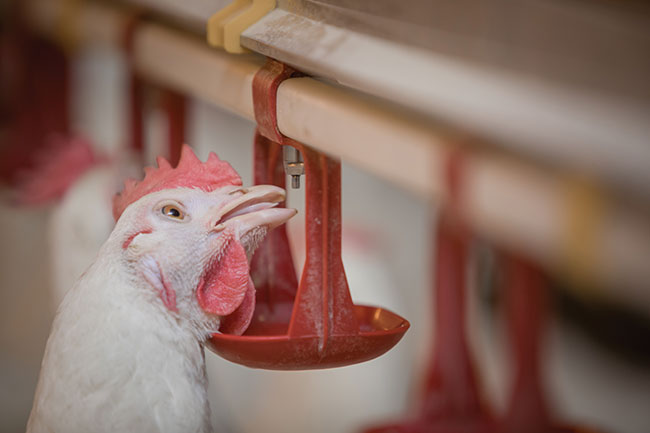
Water key to animal welfare
By Mary K. Foy
Features Barn Management water qualityWater quality key to flocks flourishing.

The legalities of how we should treat animals, and specifically food animals, can be debated for days. But the reality is that a good farmer instinctively knows that their livelihood depends on their animals flourishing.
I emphasize “good”. Calling yourself a farmer is easy. Succeeding and being “good” at it seems like a divine talent some days.
The list of what the grower cannot control is long – weather, the hatch history, etc. So, it is vital to a grower’s success that they do all they can to maximize what they can control. One of the things they can control, for the most part, is the quality of the water they give their birds.
As I’ve discussed columns, the properties of the water on the farm can have a direct impact on bird and equipment performance. How do you know if you have low-quality water? There are a few telltale signs you can look for and then there are some recommended tests to dig a little deeper.
Looking for water issues
Have the birds decreased the amount of water they drink?
Don’t know? Try putting a water meter on your water line and keeping a daily log of how much the birds drink. Most modern control panels can do that for you, too.
How often do you change filters?
Ok, how often should you be changing the filters? If you are changing the filters more than once every two weeks its time to up your filtration game.
How are your birds performing?
Are they flushing (have diarrhea)? This could be either a mineral problem, a bacterial problem or both. Do they look great but just never put on any weight at a certain point? Lack of weight gain can also be an availability problem. Have you tested your drinker flow lately?
Are your drinkers sticking open and getting the floors wet?
When you walk the water line and trigger the drinkers are some sticking? Think about this – if you have five drinkers in a row and one is stuck shut, that’s a 20 per cent reduction in the available water for the birds in that area. Drinkers that are stuck open or shut could once again be caused by either a mineral problem, a bacterial problem or both.
Is there a slimy residue on the drinkers?
Open the water line at a joint and feel the inside. Slimy? Something is growing then. Keep in mind that even if you don’t see or feel a build-up on the parts of the water line, different kinds of bacteria produce different kinds of biofilm. Some have a hard, clear coating protecting them that you can’t see or feel.
Testing for water issues
Mineral tests
Ph is what most growers think of first with mineral testing. A grower can test his own pH with some pretty reliable meters. Most agree that a pH of 5.5 to 6.5 is ideal for poultry drinking water. Sending off a sample of water for mineral testing can get you much more information than just pH, though.
You cannot always see every present mineral just by looking at what catches on the filters in the system. Look for a lab that can test turbidity, calcium, iron, sulfates, chlorides, sodium, zinc, nitrates, magnesium and manganese.
These are a few of the common minerals in source water that can impact bird performance.
Mineral tests are usually very easy to collect. Choose a spigot as close to the source as possible, let the water run until the pump kicks on, collect about 12 ounces or so in a clean (does not have to be sterile) collection container, seal it and send it to a proper mineral testing laboratory.
Bacteria tests
As I stated earlier, even if you don’t see a biofilm in the water system you may still have a bacteria problem. Some bacteria produce a hard, clear biofilm and some bacteria just cling to the walls of the water system without producing a protective layer at all.
The only way to know they are there is to test for them.
If you haven’t cleaned your water lines lately or if you don’t treat your water during grow-out you can assume there are organisms living in the water line.
The fact is that not all bacteria in our world are bad, but good or bad, you do not want them growing in the poultry water line.
At the least anything growing in the drinkers can keep the drinkers from working properly and, at the most, “other” bacteria can help hide and protect pathogens such as Salmonella or Campylobacter. Contact a lab that tests water to get their specific instructions on collecting a bacteria sample. Bacteria sampling takes some preparation – follow the lab’s directions.
Most water quality issues can be solved with proper water treatment, filtration and maintenance of the water system. Sometimes it’s easy, sometimes it is not. Every farm is different, but when it comes to taking care of the animals that allow us to provide well for our own families, the “good” farmer is going to also make sure his animals are well cared for.
Mary K. Foy is the director of technical services for Proxy-Clean Products. The U.S. company’s cleaning solution is used in Canada as part of the Water Smart Program developed by Weeden Environments and Jefo Inc.
Print this page